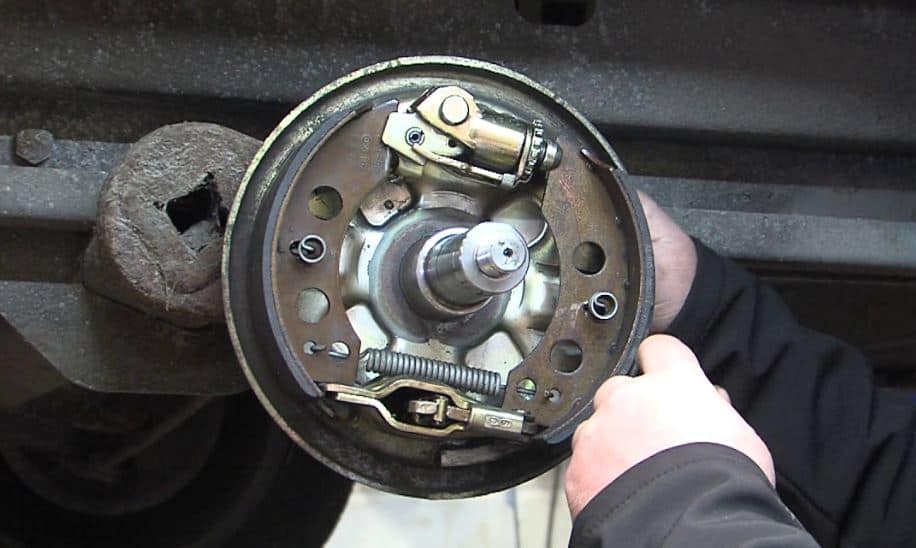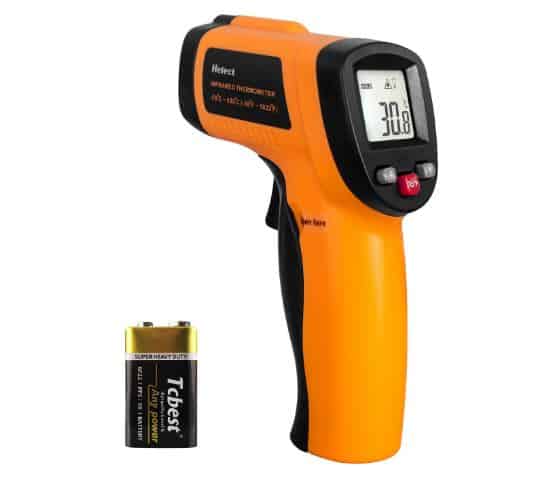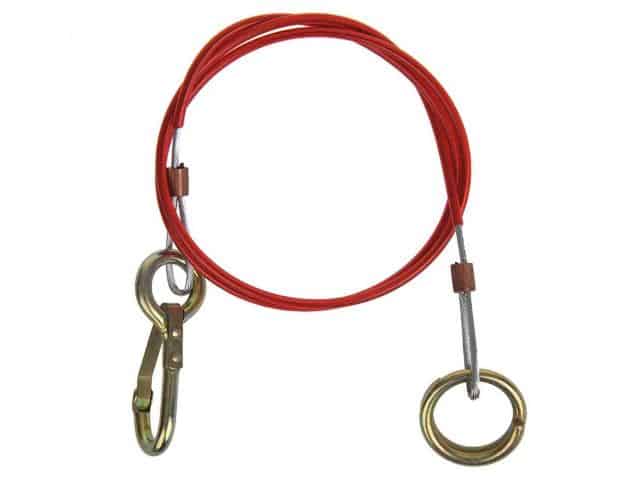
When you set off in your caravan, you want to be confident the brakes are in good working order. Therefore as part of caravan servicing, the brakes get a lot of attention as you would expect. Now, while this post is intended to make you aware of how the brakes on a caravan work, its not an endorsement of DIY caravan brake repair. My intention in highlighting the information below is so that if you believe your caravan brakes are not working as they should, you will be more aware of the potential faults. You should then book your caravan in with your service centre to have the caravan’s brakes checked out.

There are quite a few topics to discuss in this post. Including how caravan brakes work, what are the consumable parts and the overrun system.
At Horton Common, our guests have to reverse their caravan from our road onto their hard-standing pitch. Many will unhitch their caravan and use their motor mover.
However, if I have a new caravanner visit us, I do encourage them to at least try and reverse the caravan as its a safe environment to learn.
I do get some new caravaners asking me whether they will be fighting the brakes on their caravan as they reverse.
This isn’t an issue (as a whole), and I’ll discuss why that’s the case below. You can also use the Table of Contents below to jump to any particular section you’re interested in.
Disclaimer: Hey! By the way… any links on this page that lead to products on Amazon or Caravan Guard are affiliate links, and I earn a commission if you make a purchase, with no additional cost to you 🙂
- Dissolves waste and removes odours naturally and has delightful mild fragrance
Want To Visit Horton Common? – Book Here
Table of Contents
Introduction To Caravan Brakes
If you have read any of my previous posts, you will know I do like to reference videos. Practical Caravan videos, I often feel, are a good starting point.
That’s also the case with this post on caravan brakes. The video below, presented by John, briefly covers the topic of how caravan brakes work:
As referenced in the Practical Caravan video, when it comes to caravan brakes and how they work, the two main topics are the Overrun system and how the brakes disengage when you are reversing the caravan.
How The Overrun Braking System Works
When it comes to discussing how caravan brakes work, the main topic of discussion is the overrun brake system. Apparently, the overrun braking system was originally referred to as a ‘surge brake’.
The overrun system applies more or less braking resistance to the caravan depending on the braking force applied to the tow hitch.
Under normal towing conditions in forward motion, the caravan tow hitch is uncompressed, and the brakes are not engaged.
When the tow vehicle starts to slow down and apply its brakes, a braking force is applied to the caravan tow hitch, which becomes depressed.
This then forces the drawbar backwards, engaging the caravan’s wheel brakes.

However, its important to note the braking force applied by the tow vehicle and the force applied to the caravan’s wheel brakes is relative.
Hence, you will only get full braking on the caravan when the tow vehicle is under heavy braking.
If you review the diagram above from AL-KO on how the overrun braking system works on a caravan, it all seems pretty self-explanatory.
However, there is a question that many people have, what about when you’re towing a caravan downhill?
Caravan Overrun Braking Downhill
Now, how your caravan overrun brakes perform going downhill varies depending on various factors. Such as what does your caravan weigh and the speed at you are travelling.
First and foremost, it depends on how steep the descent down the hill actually is. For instance, if its only a gradual decline, such as 10%, the caravan brakes are not likely to engage.
However, if the decline was very steep such as 20%, its likely the caravan will be trying to ‘overrun’ the tow vehicle. Hence the caravan brakes will be applied.
If you are travelling down a short steep hill, other than watching your speed, so the outfit is under control, the caravan brakes should perform just fine.
However, if its a very long and steep hill and the caravan brakes are engaged for a significant amount of time, you may want to stop along the way.
Caravan brakes can overheat, they are not ventilated like the disk brakes on your car. Caravan brakes are drum brakes. If you have a heavy caravan, its likely even more braking force will have been applied.
Hence the brakes may take more time to cool. Extensive heat over time can cause the brake shoes to delaminate (more details below).
Caravan Braking Stabilisation Systems
Its likely you will have a caravan stabiliser hitch fitted to your caravan. However, you may also have a system fitted, such as the AL-KO ATC (Automatic Trailer Control).
This is an electronic system that runs off the 12V supply from your tow car.
I’ve discussed the ATC system in detail in my previous post, which you can read through the link above. But briefly, this system will engage the brakes on your caravan under a sway/snaking situation.
Reversing A Caravan & Brake Deactivation
When you put your tow car into reverse with the caravan on the back, initially, as you reverse the caravan, the brakes will engage.
Therefore, at the start of reversing, you will feel resistance from the caravan. However, as the car continues to reverse the caravan, something else happens.
A lever within the caravan’s drum brakes detects the caravan is going backwards and disengages. Hence, the caravan brakes no longer function.
This is actually why its not a good idea to reverse your caravan up onto levelling ramps, as you have less control to stop the caravan if you go too far.
Caravan Brake Hub Assembly
In the Practical Caravan video above, John shows how the brake release lever pivots out of the way to disengage the brakes as the caravan reverses.
He also shows what a vital role the spring on the brake release lever plays in re-engaging the brakes when the caravan moves forward.
However, I’ve also found another video that I think demonstrates the caravan brake hub components more clearly.
This video is actually from a training course for MCEA, the Mobile Caravan Engineers Association.
Star Wheel Adjuster
As you can see in the video above, the star wheel adjuster is used to…adjust the brakes.
Pretty simple really, by rotating the star wheel adjuster forwards or backwards, the brake shoes are moved either closer or further away from the brake drum.
As you may have noticed before in my post on caravan servicing, before the service centre removes the brake drum, they often use the star wheel adjuster to create an additional clearance between the brake shoes and drum.
Once the brakes have been serviced, they then use the star wheel adjuster to set the brake shoes just shy of the drum.
Therefore, when the braking system is engaged, there is only a short delay before the brake shoes engage.
When your caravan brakes are serviced, if the brake shoes are in good condition, they can be reused. However, brake shoes are a wearing part.
Therefore, their depth is decreased with more use. The star wheel adjuster can be used to reduce the clearance, which will be created as the pads wear.
Hence, why its important that your caravan brakes are serviced and adjusted annually.
Even if the condition of the brake shoes is fine, its likely the star wheel adjuster will need to be used to reduce excessive clearance between the brake shoes and drum.
Caravan Brake Servicing
So now, hopefully, you have a pretty good understanding of how the brakes work on a caravan and how they are adjusted.
If you are going to inspect your caravan brakes your self its essential you have the correct tools, such as a good caravan jack.
You will also need an AL-KO one shot nut to put the caravan brake assembly back together.
I’m not encouraging you to carry out DIY brake maintenance, I would encourage you to take your caravan to a service centre. However, if you are going to do it yourself, you need to do it properly.
Caravan Brake Hub Cleaning
The brake shoes are consumable wearing parts. Each time your caravan brakes are applied, brake dust is created from the shoes contacting the interior surface of the drum.
As previously mentioned, caravan brakes are not ventilated. Hence all that brake dust stays within the brake drum, and the area needs to be cleaned during a service.
Typically some form of degreasing solution or spray brake cleaner is used.
Brake Shoe Inspection and Replacement
To properly inspect the condition of the brake shoes on the caravan, they must be removed.
I think the video above on caravan brake servicing does an excellent job of highlighting the different ways brake shoes can fail.
Brake Shoe Delamination
This is effectively when the wearable friction surface of the brake shoe becomes detached from its metal body.
There can be partial delamination or full delimitation where the two parts completely separate, as seen in the video.
The reason brake shoe delamination can occur can simply be down to a manufacturing defect.
However, it can also be the result of the brakes overheating. Hence, why its important to not let your caravan brakes get too hot, which I’ll discuss more below.
Brake Shoe Cracks & Pitting
There are times when the caravan brake shoes may develop cracks and ‘pitting’. Cracks sooner or later are going to lead to delimitation and separation.
The issue with pitting is that it creates an uneven wearing surface on the brake shoe. Hence, there is less point contact between the brake shoe and the steel drum.
In both cases, the brake shoes will need to be replaced.
Brake Shoes That Are Simply Worn Out
As stated in the video by the technician, from time to time, the caravan’s brake shoes may simply be worn down to their metal body.
With proper annual servicing, it should not get to this point. When it does your caravan brakes are simply not effective.
Most caravanners don’t use their caravan enough to wear down the brake shoes to this extent. Brake shoes more often need to be replaced due to delamination, cracking or pitting.
However, just like the video shows with caravan tyres, wear is not purely indicated by the depth of the pad or tread on the tyre.
Caravan tyres need to be changed when cracking appears and at a certain age. They also need to be inflated to the correct tyre pressure.
How To Monitor Brake Temperature
So at a couple of points above in this post, I’ve discussed that, for instance, going down a steep hill, the brakes on your caravan may get hot and need to cool down.
But how can you monitor your caravan brakes when you stop at the motorway services etc? Note, this also applies to the brakes on your car.
The most basic test is to hold your hand near the brakes but do not touch them. If you can feel the heat radiating from the brakes, you need to let them cool down.
If you have been travelling down a steep hill, its likely to be a temporary issue.
However, say you have been going along a flat motorway, and your car or caravan brakes are emitting a lot of heat.
That probably indicates they may be worn out, and there is metal-to-metal contact. Instead of using your hand to ‘feel’ the heat, a better method is to have a cheap infrared heat gun with you:

I’ve had issues in the past with the cylinders on the brake discs of my car seizing up. I once stopped at a set of traffic lights and saw what I thought was smoke coming from the engine.
It was actually coming from my disc brakes. The brake cylinder would not release, and it clamped the pads against the disc.
From time to time, I now use an infrared heat gun after a trip on the motorway to check all the car brakes are at a ‘reasonable’ temperature.
If your caravan brakes are exceeding 80 degrees celsius, they need to be left to cool and may require further inspection.
The Caravan Brakeaway Cable
So finally, within this post, I didn’t want to forget to mention the brakeaway cable. Put simply, every caravan should have one, and you should always use it.
When you hitch up your caravan to your car, the brakeaway cable also needs to be connected to the car.
Now, there is a wide range of methods to attach the brakeaway cable to your tow car, and I’ll discuss that in another post.
What the caravan brakeaway cable does is engage the handbrake on your caravan, and hence the drum brakes if your caravan becomes unhitched.

If when you purchased your caravan, it didn’t come with a brakeaway cable, you need to get one and fit it before you take your caravan on the road again.
Furthermore, from time to time, the brakeaway cable can become damaged and may need replacing. Try and find a replacement that matches your existing brakeaway cable for length and cable gauge diameter.
Conclusions On Caravan Brakes
Proper inspection and maintenance of your caravan brakes on an annual basis is an essential part of being a responsible caravanner.
The internal components of the brake drum will need to be cleaned, re-greased and adjusted to suit shoe pad depth.
Potentially, the shoe pads may need replacing due to issues such as delamination, cracking and pitting.
I hope you learnt something new today about caravan brakes and why its important they are serviced on an annual basis.
I also hope you consider coming to visit us here at Horton Common in the future to try our fully serviced pitches. 🙂
FAQ
Any trailer (caravan) with a weight over 750kg is going to require a braking system. Therefore, for all intents and purposes, all ‘full-sized ‘ touring caravans in the UK are braked.
However, most teardrop caravans are below 750kg. Therefore they may not be fitted with a braking system.
Some believe that its illegal to have electric caravan brakes in the UK, for instance, such as those fitted to American caravans.
The truth, as often is the case is more complicated than a simple yes or no answer. As standard, the electric brakes and braking system fitted to an American caravan may be illegal in the UK, but they can often be modified.
Gov.uk has provided specific guidance on how electric caravan braking systems can be made legal for UK roads.
Want To Visit Horton Common? – Book Here


